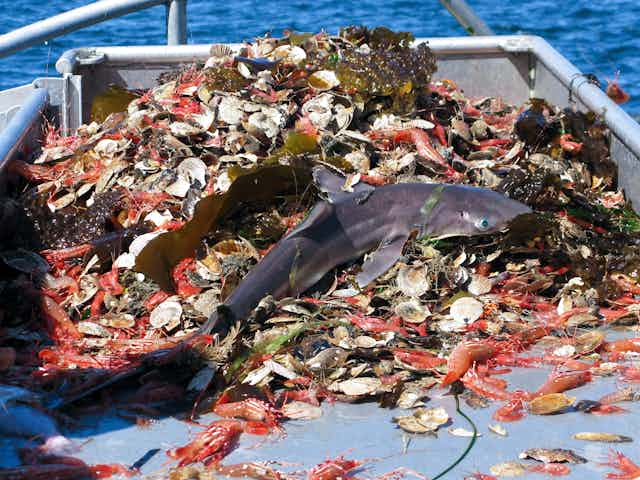As we head into the Anthropocene epoch, the era in which humankind has become the prevailing influence on our planet, we often stand accused of inadvertently running “global experiments” through our effects on wildlife, food chains, landscapes and the climate.
But what if these experiments are exactly the kind of science we need?
Of course, we’re not suggesting we deliberately trash the planet in the name of science. But if these phenomena are happening anyway, the least we can do is learn something along the way. That’s what experiments are for, right?
With science budgets shrivelling, the apparent alternative is to channel funding into ever smaller, shorter and cheaper experiments. But good luck recreating the complex tapestry of life in a coral reef, say, when all you have is a 10-cubic-metre tank.
Our research, published in the journal Ecosystems, argues that one of the only feasible solutions to the current intellectual and financial crisis lies in “large-scale, unreplicated natural experiments”, or LUNEs. These “off-the-shelf”, expansive experiments have inadvertently been created by humanity and nature.
Think tsunamis, deep earthquakes, oil spills, shark finning, alien invasions (yellow crazy ants, not Martians), and the construction of the Suez Canal.
Together, these rare but powerful manipulations of the environment can be tapped by scientists to test important hypotheses about how the world works.

Letting nature and human activity do the “dirty work” when it comes to experimental design has its advantages: it’s cheap, it’s realistic, and in many cases it’s the only ethical or logical way to study a particular question. In cases of human activity, it also allows us to understand the ecosystem response to these “interventions”.
There is also a growing consensus that no matter how many small-scale or theoretical studies we churn out, things often play out alarmingly differently when we examine ecological processes at large scales.
For example, you might be forgiven for thinking that an invasion of poisonous cane toads would be bad news for the snakes that eat them (and that’s what most studies have suggested). But a recent large-scale analysis found not just that many snake species were unperturbed by invasive toads, but that some lucky groups even increased in abundance.
Why else should we give LUNEs a chance? For statistical reasons, they are a particularly powerful tool when they operate across an ecological gradient, potentially allowing us, for example, to identify “tipping points” within ecosystem function.
In addition, gradual accumulations of LUNEs can ultimately power meta-analyses that can be used to draft robust “rules of thumb” about how ecological processes work.
For example, you might think that marine protected areas (MPAs) are a no-brainer when it comes to generating environmental and economic benefits. But this has been surprisingly difficult to prove scientifically. However, a 2014 meta-analysis of 87 MPAs showed conclusively that they help fish grow bigger and more abundant, particularly when these marine reserves are old, large, well-enforced, and have no-take fishing rules.
Deliberate oil spills?!
But LUNEs constitute a Faustian bargain, damaging the natural world in return for more knowledge. That also means they’re generally impossible to replicate, because it’s hard to run the experiment for a second time, even if you were mad enough to want to.
The US government is unlikely to green-light a second Deepwater Horizon oil spill, earthquakes are unpredictable and different each time, and we’re (hopefully) unlikely to experience another Big Bang any time in our near future.
An important question LUNEs raise is whether the conventional scientific need for experimental replication surpasses the urgent need to understand humanity’s effects on the planet.
We argue that the “conceptual” replications LUNEs offer are far more valuable than exact, controlled scientific replications, which when carried out on small scales can be highly misleading anyway.
Here’s an example. Water quality declined in many North American rivers and lakes in the 1960s, turning them green with nutrient-driven algal blooms. Small-scale experiments pointed the finger at nitrogen and carbon, but when researcher David Schindler began deliberately injecting whole lakes in western Ontario with different nutrients, he realised that phosphorus was the crucial factor.
His research didn’t use traditional scientific replication. But the results were eventually enough to persuade the Canadian government and several US states to ban phosphorus, which is now recognised as the major culprit.

In other cases, LUNEs have not overturned scientific consensus, but have proved crucial in highlighting the seriousness of the issues. There was 20 years’ worth of evidence from small-scale lab experiments and modelling studies about the dangers of chlorofluorocarbons used as refrigerants and aerosol propellants. But the world only moved to ban them after the discovery that these chemicals had punched a large hole in the ozone layer over Antarctica.
Together, these examples suggest that LUNEs and other large-scale studies can play a crucial role in galvanising the policy changes that avert environmental crises.
Homo sapiens derives from the Latin sapientia, meaning “wisdom”. But our ongoing failure to use our planet’s resources sustainably suggests that we are still a long way from living up to our name.
Fast-tracking LUNES and other large-scale studies, and placing value on their findings, may help us develop the far-sightedness we’ll need to survive the Anthropocene epoch.

